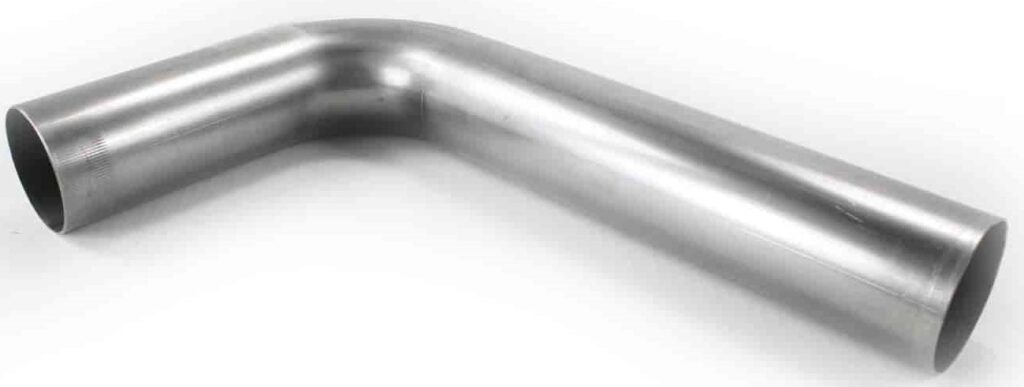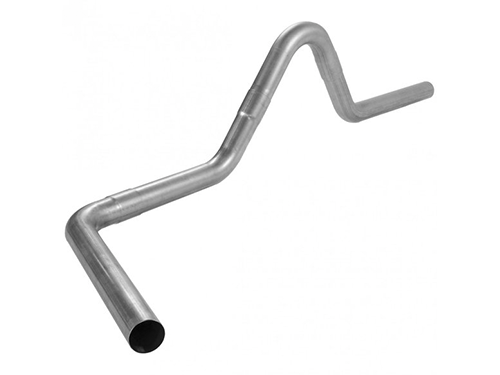Sign up now to join the JEGS email newsletter and be the first to learn about new products, special deals and e-mail only offers!


How your exhaust pipe is bent means more than you might think, so it’s important to know what type of bend you have or need if you’re looking to maximize your engine’s performance. In fact, something as simple as a bend can impact your exhaust system’s performance, durability, and emissions.
Thankfully, we’re here to help you learn everything you need to know about exhaust bends and how it affects your car. Read on to learn more below.
Every combustion engine needs an exhaust system to transport the gasses created by combustion away from the engine and passenger compartment. The engine is usually located in front of the cabin, in an elevated position, so it would be an odd design choice to have the exhaust pipe run straight through the cabin. This is where exhaust bends come into play.
Most vehicles leverage exhaust bends to help the exhaust pipe navigate around various components underneath the vehicle. For example, a bend in the exhaust can help it get around the suspension, chassis, axles, and other components.
Aside from helping an exhaust fit properly, there are some other benefits to exhaust bends. One such benefit is heat dissipation for exhaust gasses. A longer exhaust can cool the exhaust gasses down before they exit the exhaust. Improving ground clearance, reducing the amount of engine noise, and changing the directional flow of exhaust gasses are some other important uses of exhaust bends.
It’s also important to note that exhaust bends can be leveraged to improve performance. Some bends can help your vehicle maintain the appropriate back pressure, which is crucial for optimal performance.
Worth a mention as well is that exhaust bends can also improve the aesthetic and exhaust notes of a high-performance exhaust system.
Several types of exhaust bends are available for automotive applications. The most common exhaust bend is the mandrel pipe, which uses a mandrel inside of the pipe to prevent the bend from crushing under pressure. Read on to learn more about the various types of exhaust bends.
Regarding exhaust bends, mandrel bends are typically the best option because they result in a smooth change in direction. While other bends can form similar shapes, the mandrels inside the pipe provide extra support you can’t find with different bend types. Mandrels consist of a small group of round balls interconnected by a cable. Typically, mandrels are made with materials like brass because it’s flexible enough to glide smoothly throughout the exhaust pipe. However, lubrication is sometimes used to make the process easier.
The major aspect that makes mandrel bends unique is what’s placed inside the pipe. Otherwise, the actual bending process is similar, so it’s only the final outcome that’s different because of the internal mandrels.

Another common type of exhaust bends is the crush bend. Most exhaust shops will have the equipment to perform crush bends, and they resemble OEM exhaust systems quite well. If you’re unfamiliar with the term Crush Bend, you might know it as Pressure, Ram, or Compression bending.
During this bending process, only a radius/bend die and backing shoes are used, so you won’t find any mandrels inside the exhaust pipe. When a crush bend occurs, the process involves bending the inside of the radius. Essentially, as the pipe is drawn across the radius die, the heel (outside) gets stretched, but the throat (inside) contracts. The result is a small depression that runs along the inside of the exhaust bend.
Crush bending is common because you don’t need expensive equipment or a lot of time. For this reason, many exhaust shops or general mechanics can perform crush bends.

Another common bending method is the wrinkle bend. This bending method is unique because it uses heat to bend exhaust piping. Wrinkle bending is only possible once the pipe is red-hot because the inside of the pipe begins to collapse under pressure as it runs across the radius die. This makes it easier for the pipe to bend, which reduces the risk of damaging the pipe with excessive pressure.
Most wrinkle-bent exhaust pipes will have an accordion-style shape and feature many wrinkles, hence the name. These wrinkles can be found along the inner section of the bend if done properly.
Wrinkle bending is less common in DIY circles because it requires tools to heat exhaust pipes to red-hot temperatures.
Sign up now to join the JEGS email newsletter and be the first to learn about new products, special deals and e-mail only offers!

Regarding exhaust bends, each type has pros and cons you need to be aware of. We take you through some advantages and disadvantages of each exhaust bend below.
Mandrel bends are high-quality bends with limited deformation because of the internal mandrels. The technique is used by some of the most well-known exhaust manufacturers in the industry, like Corsa, because it results in premium exhaust pipes.
Pros:
Cons:
Despite the pros and cons of mandrel bends, it’s almost always the best option.

Wrinkle bends aren’t too common because the equipment is expensive to use and maintain. However, it’s often safer than crush bending if you know what you’re doing. Learn more about the pros and cons of wrinkle bends below.
Pros:
Cons:
Overall, wrinkle bends are efficient and low-risk as long as you know what you’re doing.
Pros:
Cons:
Crush bends are a great option if you’re in a pinch because most shops will have the tools to do so. However, you risk a lack of quality and performance.
Always keep your goals in mind before choosing any of the bending methods. Unfortunately, the wrong method might result in costly damage to your exhaust system.




